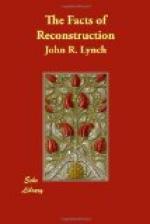This action, no doubt, resulted in the defeat of General Grant for the nomination; for it was a well-known fact that his nomination was possible only through the enforcement of the unit rule. His friends and supporters, however, under the leadership of Senator Conkling, made a strong and desperate fight with the hope that the tide might ultimately turn in their favor, but with the intention, in any event, of preventing if possible the nomination of Mr. Blaine. General Grant’s name was placed before the Convention by Senator Conkling in one of his most eloquent and masterly efforts.
“The man whose name I shall place in nomination,” he said, “does not hail from any particular State; he hails from the United States. It is not necessary to nominate a man that can carry Michigan. Any Republican can carry Michigan. You should nominate a man that can carry New York. That man is U.S. Grant.”
Mr. Blaine’s name was placed in nomination by a delegate from Michigan by the name of Joy. His effort did not come up to public expectation. The eloquent speech of Senator Frye, of Maine, who seconded the nomination, made up in part for the public disappointment in Mr. Joy’s effort. The name of Secretary John Sherman was placed before the Convention in one of General Garfield’s most powerful and convincing efforts. It is safe to say that the speech delivered by General Garfield on that occasion made him the nominee of that convention. After drawing an eloquent and vivid picture of the kind of man that should be made President,—with the intention of naming John Sherman as the man thus described,—he asked in a tone of voice that was pitched in a high key:
“Who is that man?”
The response came from different parts of the hall, “Garfield.”
And sure enough it was Garfield. After a number of fruitless ballots it became apparent that neither of the three leading candidates could possibly be nominated. Very few, if any, of the Grant men would at any time go to either Blaine or Sherman. Very few, if any, of the Sherman men would go to Blaine, while Blaine men could not in any considerable numbers, be induced to go either to Grant or Sherman. While a number of Sherman men would have supported Grant in preference to Blaine, there were not enough of them, even with the Grant men, to constitute a majority. When Garfield’s name was suggested as a compromise candidate he was found to be acceptable to both the Blaine and the Sherman men as well as to some of the Grant men, who had abandoned all hope of Grant’s nomination. The result was that Garfield was finally made the unanimous choice of the convention. The New York delegation, being allowed to name the man for Vice-President, nominated Chester A. Arthur, of that State.
Although General Garfield was nominated as a compromise candidate his election was by no means a foregone conclusion. The Democrats had nominated a strong and popular man, General W.S. Hancock, one of the most brilliant and successful generals in the Union Army. Associated on the ticket with him was a popular Indiana Democrat, William H. English. It looked for a while as if Democratic success were reasonably certain, especially after the September State and Congressional elections in the State of Maine, the result of which was virtually a Democratic victory.




